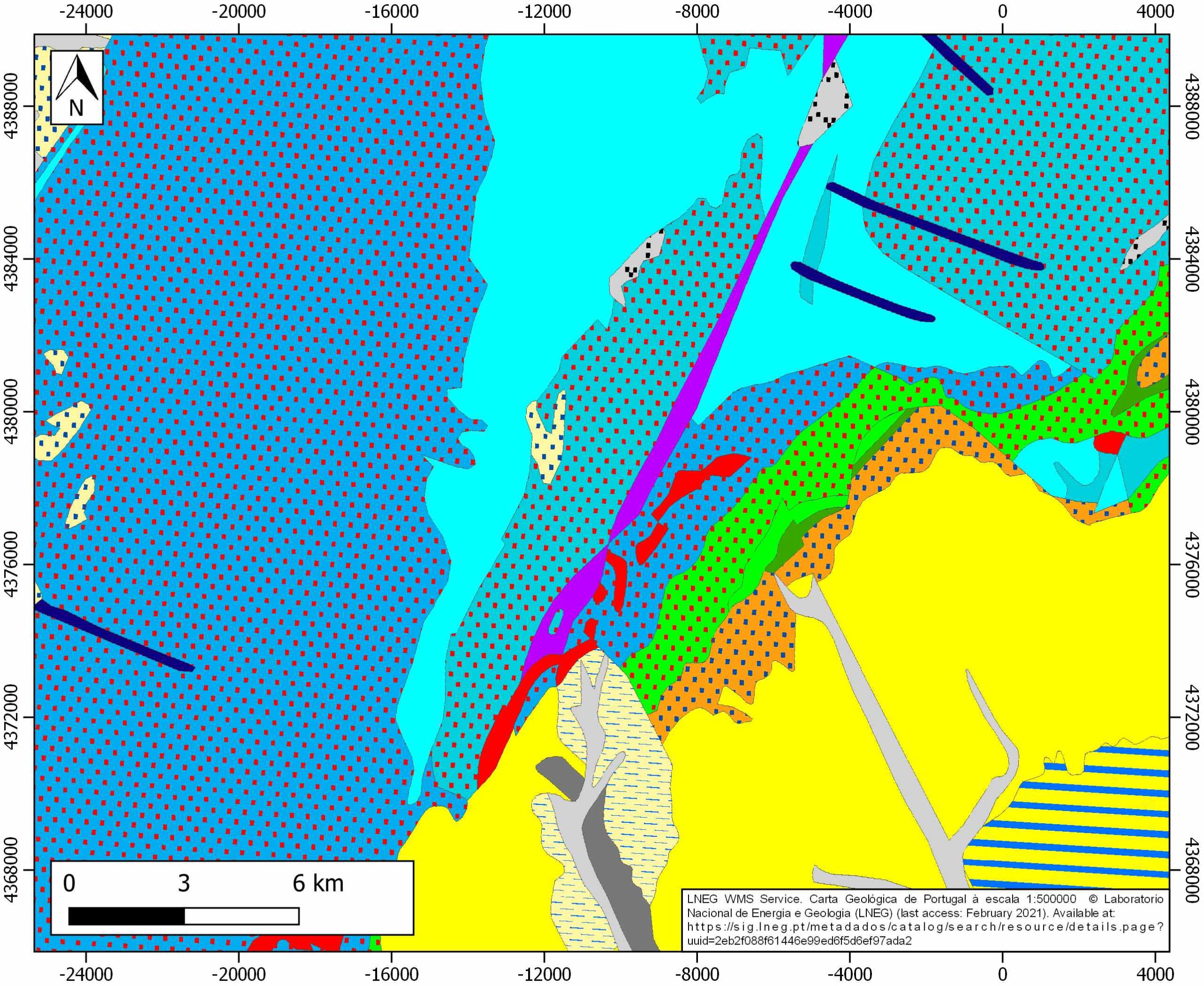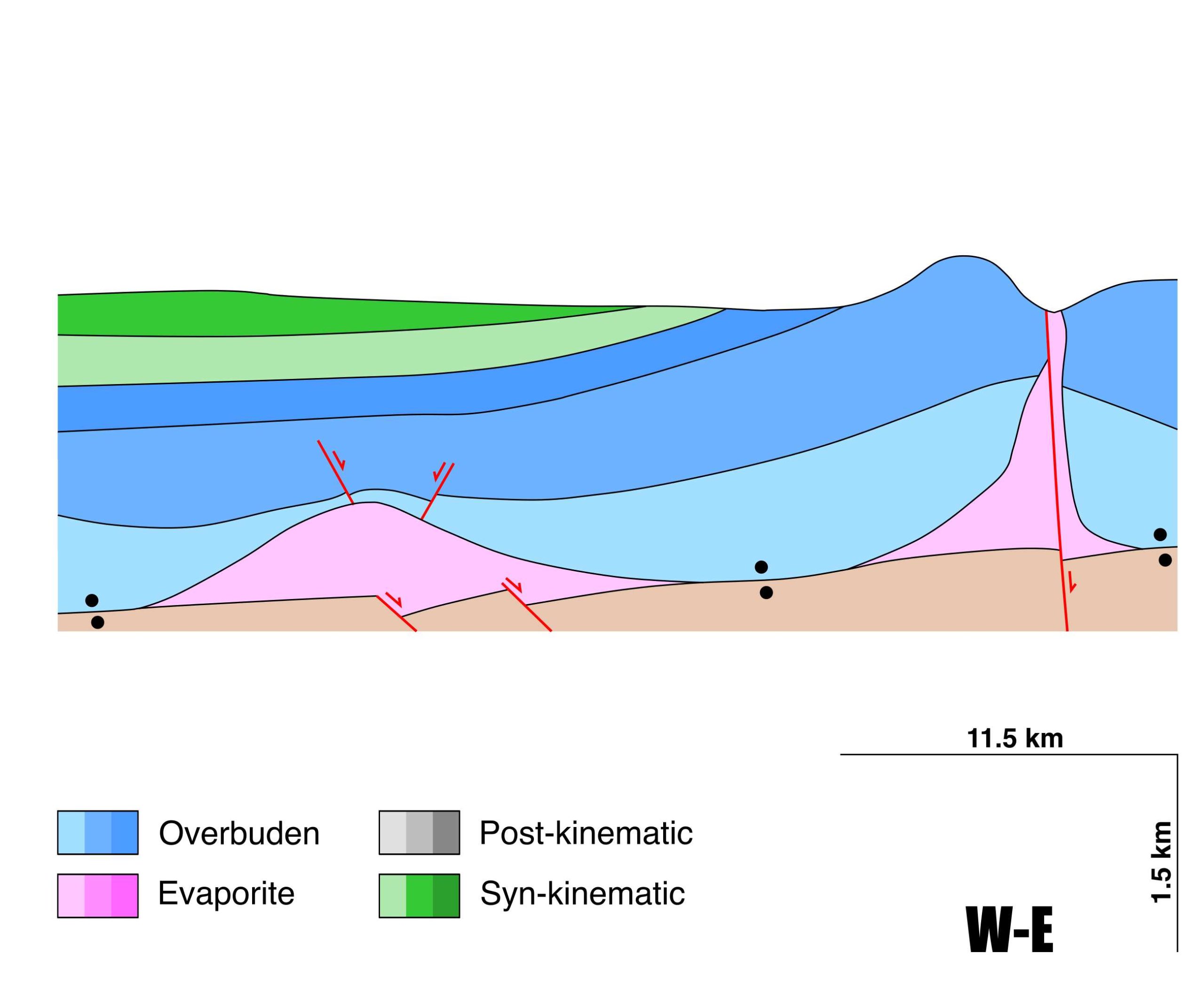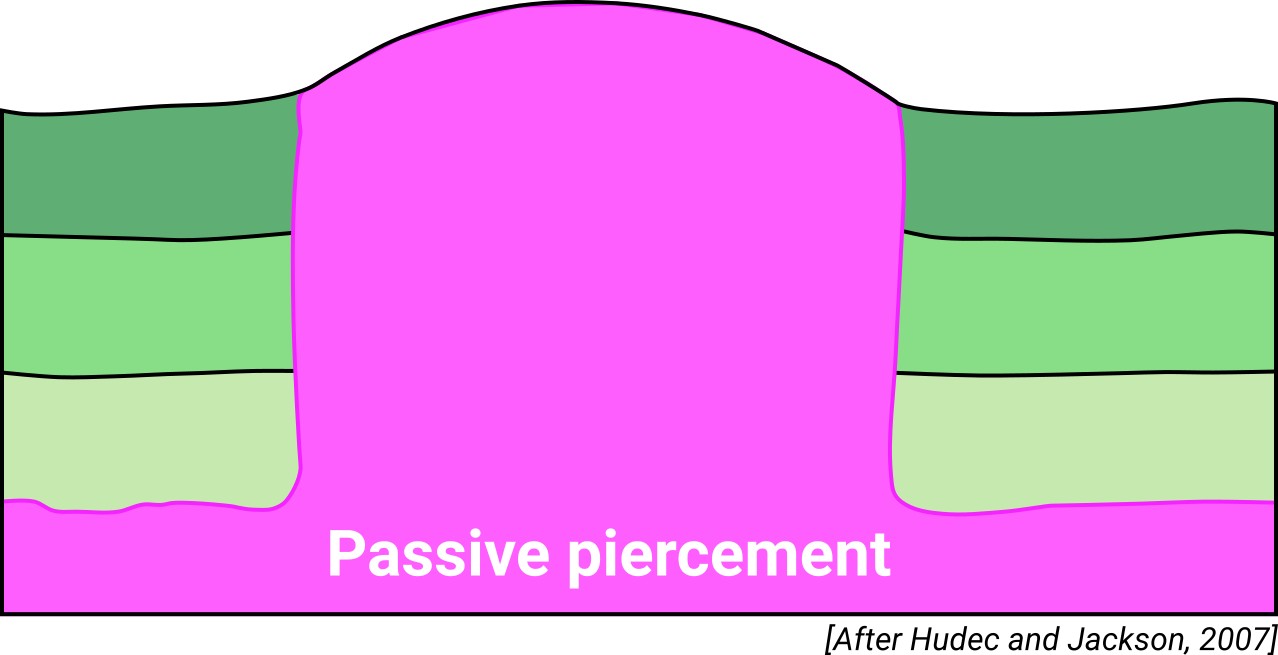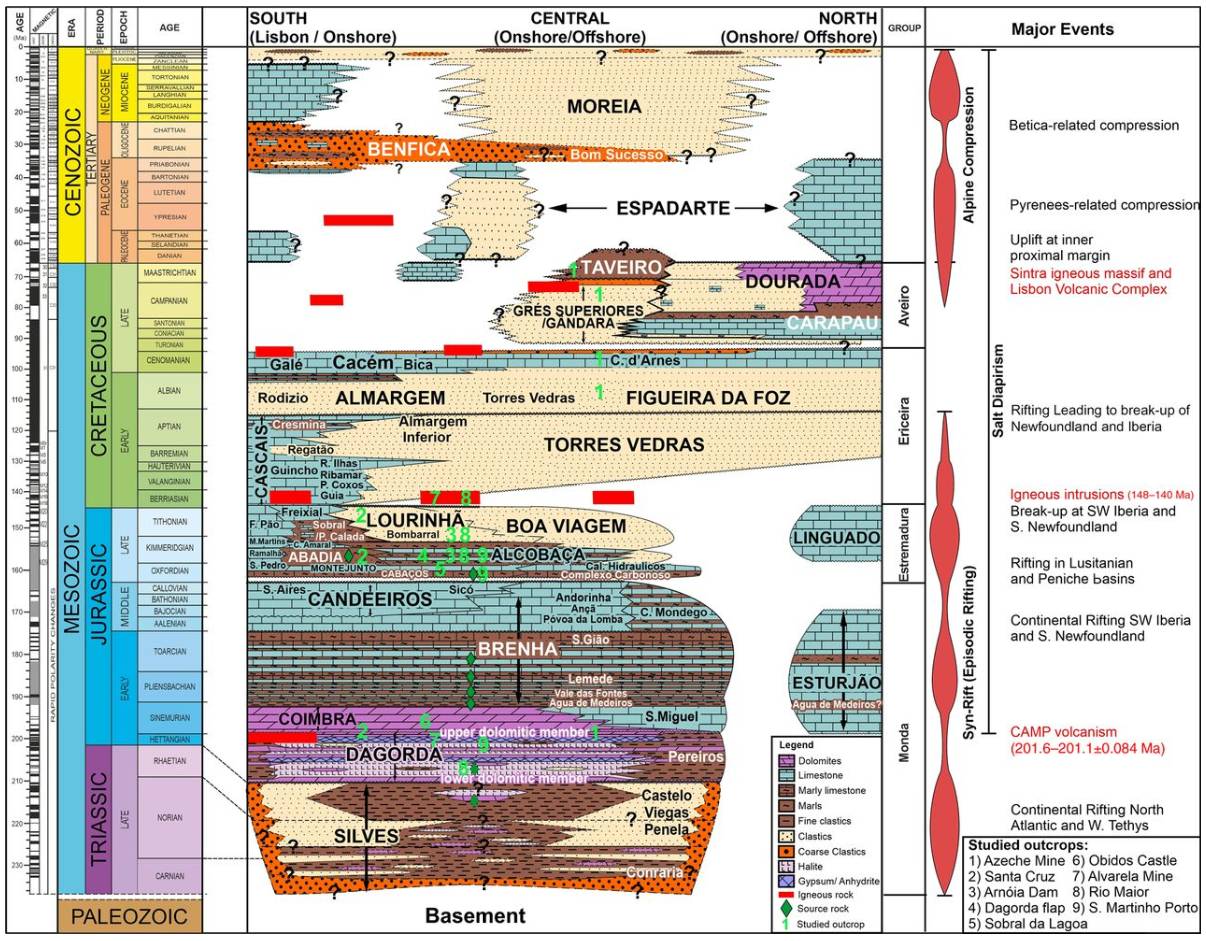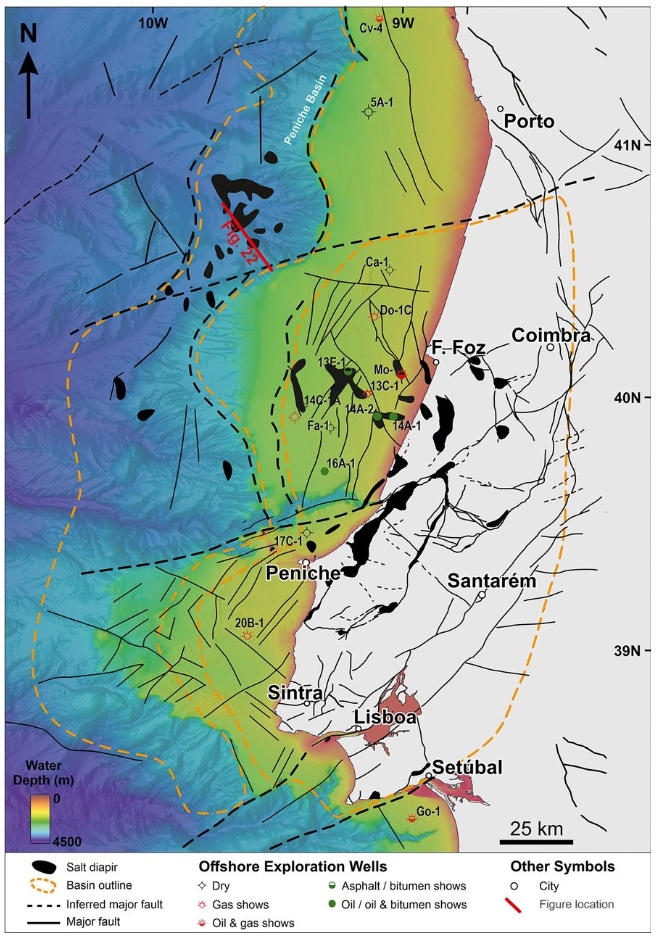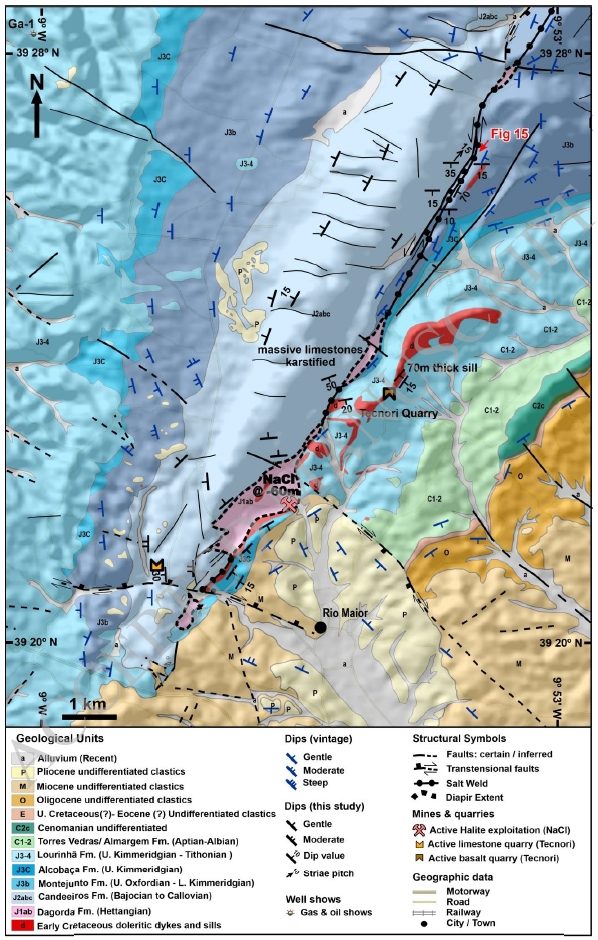General Information
| Structure type | Evaporite-cored anticline |
| Deformed/Undeformed | Deformed |
| Geological Setting | Eastern Domain, Lusitanian Basin |
| Outcropping/buried | Outcropping |
| Evaporite unit/s name | Dagorda Fm. |
| Evaporite unit/s age | Late Rhaetian-Hettangian (Upper Triassic-Lower Jurassic) |
| Evaporite unit/s origin | Marine |
| Classif. (Hudec and Jackson, 2009) | Passive piercement |
| Classif. (Jackson and Talbot, 1986) | Salt wall |
| Age of evaporite flow or deformation (when deformed) | late Cretaceous to Miocene, Upper Jurassic to Upper Cretaceous |
| Other comments | Diapir developed in transtensional zones along a strike-slip fault, and then being reactivated during highly-oblique sinistral transpression in the Miocene. Highly squeezed during the Betic orogeny (see Davidson et al., 2020). |
Generic Data
| Unique ID | 98 |
| Name | Rio Maior |
| Structure type | Evaporite-cored anticline |
| Deformed/Undeformed | Deformed |
| Buried/Outcropping | Outcropping |
| Geological setting | Lusitanian Basin |
| Geological Regional Setting | Eastern Domain |
| Evaporite unit/s name | Dagorda Fm. |
| Evaporite unit/s age | Late Rhaetian-Hettangian (Upper Triassic-Lower Jurassic) |
| Evaporite unit/s era | Mesozoic |
| Evaporite unit/s origin | Marine |
| Evaporite unit/s composition | Gypsum-Marlstone-Halite-Bituminous dolomite-Shales |
| Post-kinematic unit/s (or post-evaporite units when evaporites are undeformed) | Pliocene (siltstones, sandstones, conglomerates) ; Quaternary (alluvial and colluvial detrital deposits) |
| Post-kinematic unit/s age (or post-evaporite units when evaporites are undeformed) | Pliocene-Holocene |
| Classification (Hudec and Jackson, 2009) | Passive piercement |
| Classification (Jackson and Talbot, 1986) | Salt wall |
| Mining activity? | Y |
| Mining activity start | Roman Empire |
| Mining activity end | Active |
| Mining galleries? | Y |
| Mining products | Halite |
| Mining sub-products | – |
| Evaporite flow? | Y |
| Age of evaporite flow | Kimmeridgian-Cenomanian and late Cretaceous-Miocene (main reactivation stage) |
| Flow or deformation triggering mechanisms | Differential sedimentary loading developed during the late Triassic to early Jurassic rift tectonics |
| Flow-linked structures? | Y |
| Halokinetic structures | Normal faults / anticline-syncline folding |
| Post-evaporite and pre-kinematic unit/s (overbuden) | Lower Jurassic (Coimbra and San Miguel Fms., dolostones) ; Mid Early Jurassic (Agua das Medeiros, Vale das Fontes and Lemede Fms, marlstones, marly limestones, limestones) ; Late Early Jurassic-Middle Jurassic (Brenha Fm., limestones, marly limestones) ; Late Jurassic (Complexo Carbonoso and Montejunto, marlstones and limestones) |
| Syn-kinematic unit/s | Kimmeridgian (Alcobasa Fm., limestones and marly limestones) ; Tithonian (Lourinha Fm., sandstones and conglomerates) |
| Available seismic profiles | |
| Available boreholes | |
| Additional comments | Diapir developed in transtensional zones along a strike-slip fault, and then being reactivated during highly-oblique sinistral transpression in the Miocene. Highly squeezed during the Betic orogeny (see Davidson et al., 2020) |
Mining Data
| UNIQUE_ID | 98 |
| Minning exploitations within <2km? | Y |
| Historical/Active | Historical (not indexed in the Spanish National Minning Cadastre) |
| Exploitation name #1 | n.a. |
| Exploitation ID (Spanish National Mining Cadastre) #1 | n.a. |
| Municipality #1 | n.a. |
| Province #1 | n.a. |
| Company #1 | n.a. |
| Main minning Products #1 | Halite |
| Exploitation name #2 | |
| Exploitation ID (Spanish National Mining Cadastre) #2 | |
| Municipality #2 | |
| Province #2 | |
| Company #2 | |
| Main minning Products #2 | |
| Exploitation name #3 | |
| Exploitation ID (Spanish National Mining Cadastre) #3 | |
| Municipality #3 | |
| Province #3 | |
| Company #3 | |
| Main minning Products #3 |
Quantitative Data
| UNIQUE_ID | 98 |
| Outcropping area (km2) | 5.41338 |
| Horizontal intersection area (km2) (when buried) | Not buried |
| Depth of intersection area (km2) (when buried) | Not buried |
| Max. Width (Km) | 14.1150784 |
| Max. Length (Km) | 1.28767777 |
| Max. Evaporites thickness (km) | 2.1 |
| Max. Deformation age (Ma) | 157 |
| Min. Deformation age (Ma) | 15 |
| Deformation stages | 2 |
Reference Data
| UNIQUE_ID | 98 |
| Section source | Davison, I., Barreto, P., 2020. Deformation and sedimentation processes, and hydrocarbon accumulations on upturned salt diapir flanks in the Lusitanian Basin, Portugal. Petroleum Geoscience, 27(1). [link] |
| Well / Borehole availability #1 | Pimentel, N., Pena dos Reis, R., 2016. Petroleum systems of the West Iberian Margin: A review of the Lusitanian Basin and the deep offshore Peniche Basin. Journal of Petroleum Geology, 39(3), 305-326. [link] |
| Well / Borehole availability #2 | Davison, I., Barreto, P., 2020. Deformation and sedimentation processes, and hydrocarbon accumulations on upturned salt diapir flanks in the Lusitanian Basin, Portugal. Petroleum Geoscience, 27(1). [link] |
| Available data (Stratigraphy) #1 | Davison, I., Barreto, P., 2020. Deformation and sedimentation processes, and hydrocarbon accumulations on upturned salt diapir flanks in the Lusitanian Basin, Portugal. Petroleum Geoscience, 27(1). [link] |
| Available data (Stratigraphy) #2 | dos Reis, R. P., Pimentel, N., Fainstein, R., Reis, M., Rasmussen, B., 2017. Influence of salt diapirism on the basin architecture and hydrocarbon prospects of the Western Iberian Margin. In Permo-Triassic Salt Provinces of Europe, North Africa and the Atlantic Margins (pp. 313-329). Elsevier. [link] |
| Available data (Stratigraphy) #3 | Alves, T. M., Manuppella, G., Gawthorpe, R. L., Hunt, D. W., Monteiro, J. H., 2003. The depositional evolution of diapir-and fault-bounded rift basins: examples from the Lusitanian Basin of West Iberia. Sedimentary Geology, 162(3-4), 273-303. [link] |
| Available data (Stratigraphy) #4 | Carneiro, J. F., Matos, C. R., Van Gessel, S., 2019. Opportunities for large-scale energy storage in geological formations in mainland Portugal. Renewable and Sustainable Energy Reviews, 99, 201-211. [link] |
| Available data (Stratigraphy) #5 | n.a. |
| Available data (Stratigraphy) #6 | n.a. |
| Regional Stratigraphy | Davison, I., Barreto, P., 2020. Deformation and sedimentation processes, and hydrocarbon accumulations on upturned salt diapir flanks in the Lusitanian Basin, Portugal. Petroleum Geoscience, 27(1). [link] |
| Seismic data availability #1 | dos Reis, R. P., Pimentel, N., Fainstein, R., Reis, M., Rasmussen, B., 2017. Influence of salt diapirism on the basin architecture and hydrocarbon prospects of the Western Iberian Margin. In Permo-Triassic Salt Provinces of Europe, North Africa and the Atlantic Margins (pp. 313-329). Elsevier. [link] |
| Seismic data availability #2 | Carvalho, J. M. F., 2013. Tectónica e caraterização da fraturação do Maciço Calcário Estremenho, Bacia Lusitaniana. Contributo para a prospeção de rochas ornamentais e ordenamento da atividade extrativa [Ph.D. thesis:]: Universidade de Lisboa, Faculdade de Ciências, Departamento de Geologia, 449pp. [link] |
| Seismic data availability #3 | Davison, I., Barreto, P., 2020. Deformation and sedimentation processes, and hydrocarbon accumulations on upturned salt diapir flanks in the Lusitanian Basin, Portugal. Petroleum Geoscience, 27(1). [link] |
| Available data (Structure) #1 | Davison, I., Barreto, P., 2020. Deformation and sedimentation processes, and hydrocarbon accumulations on upturned salt diapir flanks in the Lusitanian Basin, Portugal. Petroleum Geoscience, 27(1). [link] |
| Available data (Structure) #2 | Pereira, N., Carneiro, J. F., Araújo, A., Bezzeghoud, M., Borges, J., 2014. Seismic and structural geology constraints to the selection of CO2 storage sites—The case of the onshore Lusitanian basin, Portugal. Journal of Applied Geophysics, 102, 21-38. [link] |
| Available data (Structure) #3 | dos Reis, R. P., Pimentel, N., Fainstein, R., Reis, M., Rasmussen, B., 2017. Influence of salt diapirism on the basin architecture and hydrocarbon prospects of the Western Iberian Margin. In Permo-Triassic Salt Provinces of Europe, North Africa and the Atlantic Margins (pp. 313-329). Elsevier. [link] |
| Available data (Structure) #4 | Carvalho, J. M. F., 2013. Tectónica e caraterização da fraturação do Maciço Calcário Estremenho, Bacia Lusitaniana. Contributo para a prospeção de rochas ornamentais e ordenamento da atividade extrativa [Ph.D. thesis:]: Universidade de Lisboa, Faculdade de Ciências, Departamento de Geologia, 449pp. [link] |
| Available data (Structure) #5 | Rasmussen, E. S., Lomholt, S., Andersen, C., Vejbæk, O. V., 1998. Aspects of the structural evolution of the Lusitanian Basin in Portugal and the shelf and slope area offshore Portugal. Tectonophysics, 300(1-4), 199-225. [link] |
| Available data (Structure) #6 | Pimentel, N., Pena dos Reis, R., 2016. Petroleum systems of the West Iberian Margin: A review of the Lusitanian Basin and the deep offshore Peniche Basin. Journal of Petroleum Geology, 39(3), 305-326. [link] |
| Available data (Analogue modelling) #1 | n.a. |
| Available data (Analogue modelling) #2 | n.a. |
| Available data (Analogue modelling) #3 | n.a. |
| Available data (Gravimetry – Tomography) #1 | dos Reis, R. P., Pimentel, N., Fainstein, R., Reis, M., Rasmussen, B., 2017. Influence of salt diapirism on the basin architecture and hydrocarbon prospects of the Western Iberian Margin. In Permo-Triassic Salt Provinces of Europe, North Africa and the Atlantic Margins (pp. 313-329). Elsevier. [link] |
| Available data (Gravimetry – Tomography) #2 | Connors, K., Pryer, L., Mcwhorter, R., Torguson, B., 2012. Basement influence within the Lusitanian Basin. Third Central & North Atlantic Conjugate Margins Conference, Trinity College, Abstracts, 31-32. [link] |
| Available data (Gravimetry – Tomography) #3 | Ayala, C., Bohoyo, F., Maestro, A., Reguera, M. I., Torne, M., Rubio, F., Fernández, M., García-Lobón, J. L., 2016. Updated Bouguer anomalies of the Iberian Peninsula: a new perspective to interpret the regional geology. Journal of Maps, 12(5), 1089-1092. [link] |
| Available data (Geochemistry) #1 | Spigolon, A. L. D., Pena dos Reis, R. P. B., Pimentel, N. L., Matos, V. G. A. E., 2011. Geoquímica orgânica de rochas potencialmente geradoras de petróleo no contexto evolutivo da Bacia Lusitânica, Portugal. Bol Geoci Petrobras, 19, 131-162. [link] |
| Available data (Geochemistry) #2 | Ferreira, E., Mateus, A., Azerêdo, A. C., Duarte, L. V., Mendonça-Filho, J., Tassinari, C. C., 2020. Tracing bottom-water redox conditions during deposition of Lower and Upper Jurassic organic-rich sedimentary rocks in the Lusitanian Basin (Portugal): Insights from inorganic geochemistry. Marine and Petroleum Geology, 104343. [link] |
| Available data (Geochemistry) #3 | Ferroni, G., Rockenbauch, K., Rivolta, F., McWhorter, R., 2013. In-Situ Geochemical Analysis of Rock Samples from Simultaneous Wells Enables Field-Wide Formation Characterization in Real-Time. In SPWLA 54th Annual Logging Symposium. Society of Petrophysicists and Well-Log Analysts. [link] |
| Available data (Geochemistry) #4 | n.a. |
| Available data (Petrophysics) #1 | Sêco, S. L., Silva, R. L., Watson, N., Duarte, L. V., Pereira, A. J., Wach, G., 2019. Application of petrophysical methods to estimate total organic carbon in Lower Jurassic source rocks from the offshore Lusitanian Basin (Portugal). Journal of Petroleum Science and Engineering, 180, 1058-1068. [link] |
| Available data (Petrophysics) #2 | Azerêdo, A. C., Inês, N., & Bizarro, P., 2020. Carbonate reservoir outcrop analogues with a glance at pore-scale (Middle Jurassic, Lusitanian Basin, Portugal). Marine and Petroleum Geology, 111, 815-851. [link] |
| IGME Geological Map (MAGNA50) Sheet number | n.a. |
| Other Maps #1 (source) | Davison, I., Barreto, P., 2020. Deformation and sedimentation processes, and hydrocarbon accumulations on upturned salt diapir flanks in the Lusitanian Basin, Portugal. Petroleum Geoscience, 27(1). [link] |
| Other Maps #2 (source) | Davison, I., Barreto, P., 2020. Deformation and sedimentation processes, and hydrocarbon accumulations on upturned salt diapir flanks in the Lusitanian Basin, Portugal. Petroleum Geoscience, 27(1). [link] |
| Other related references #1 | dos Reis, P., Cunha, P. P., Dinis, J., Trincão, P. R., 2000. Geological evolution of the Lusitanian Basin (Portugal) during the Late Jurassic. 5th Jurassic Symposium, Vancouver, 6, 345-356. [link] |
| Other related references #2 | Mateus, O., Dinis, J., & Cunha, P. P., 2017. The Lourinhã Formation: the Upper Jurassic to lower most Cretaceous of the Lusitanian Basin, Portugal–landscapes where dinosaurs walked. Ciências da Terra/Earth Sciences Journal, 19(1), 75-97. [link] |
| Other related references #3 | n.a. |
| Other related references #4 | n.a. |
Well and Seismic Data
| UNIQUE_ID | 98 |
| Seismic survey name #1 | |
| Across structure? #1 | |
| Seismic profile ID (IGME) #1 | |
| Seismic profile code #1 | |
| Seismic profile name #1 | |
| Seismic survey year #1 | |
| Data repository #1 | |
| Length (km) #1 | |
| Seismic survey name #2 | |
| Across structure? #2 | |
| Seismic profile ID (IGME) #2 | |
| Seismic profile code #2 | |
| Seismic profile name #2 | |
| Seismic survey year #2 | |
| Data repository #2 | |
| Length (km) #2 | |
| Seismic survey name #3 | |
| Across structure? #3 | |
| Seismic profile ID (IGME) #3 | |
| Seismic profile code #3 | |
| Seismic profile name #3 | |
| Seismic survey year #3 | |
| Data repository #3 | |
| Length (km) #3 | |
| Seismic survey name #4 | |
| Across structure? #4 | |
| Seismic profile ID (IGME) #4 | |
| Seismic profile code #4 | |
| Seismic profile name #4 | |
| Seismic survey year #4 | |
| Data repository #4 | |
| Length (km) #4 | |
| Seismic survey name #5 | |
| Across structure? #5 | |
| Seismic profile ID (IGME) #5 | |
| Seismic profile code #5 | |
| Seismic profile name #5 | |
| Seismic survey year #5 | |
| Data repository #5 | |
| Length (km) #5 | |
| Seismic survey name #6 | |
| Across structure? #6 | |
| Seismic profile ID (IGME) #6 | |
| Seismic profile code #6 | |
| Seismic profile name #6 | |
| Seismic survey year #6 | |
| Data repository #6 | |
| Length (km) #6 | |
| Seismic survey name #7 | |
| Across structure? #7 | |
| Seismic profile ID (IGME) #7 | |
| Seismic profile code #7 | |
| Seismic profile name #7 | |
| Seismic survey year #7 | |
| Data repository #7 | |
| Length (km) #7 | |
| Seismic survey name #8 | |
| Across structure? #8 | |
| Seismic profile ID (IGME) #8 | |
| Seismic profile code #8 | |
| Seismic profile name #8 | |
| Seismic survey year #8 | |
| Data repository #8 | |
| Length (km) #8 | |
| Seismic survey name #9 | |
| Across structure? #9 | |
| Seismic profile ID (IGME) #9 | |
| Seismic profile code #9 | |
| Seismic profile name #9 | |
| Seismic survey year #9 | |
| Data repository #9 | |
| Length (km) #9 | |
| Seismic survey name #10 | |
| Across structure? #10 | |
| Seismic profile ID (IGME) #10 | |
| Seismic profile code #10 | |
| Seismic profile name #10 | |
| Seismic survey year #10 | |
| Data repository #10 | |
| Length (km) #10 | |
| Seismic survey name #11 | |
| Across structure? #11 | |
| Seismic profile ID (IGME) #11 | |
| Seismic profile code #11 | |
| Seismic profile name #11 | |
| Seismic survey year #11 | |
| Data repository #11 | |
| Length (km) #11 | |
| Seismic survey name #12 | |
| Across structure? #12 | |
| Seismic profile ID (IGME) #12 | |
| Seismic profile code #12 | |
| Seismic profile name #12 | |
| Seismic survey year #12 | |
| Data repository #12 | |
| Length (km) #12 | |
| Seismic survey name #13 | |
| Across structure? #13 | |
| Seismic profile ID (IGME) #13 | |
| Seismic profile code #13 | |
| Seismic profile name #13 | |
| Seismic survey year #13 | |
| Data repository #13 | |
| Length (km) #13 | |
| Seismic survey name #14 | |
| Across structure? #14 | |
| Seismic profile ID (IGME) #14 | |
| Seismic profile code #14 | |
| Seismic profile name #14 | |
| Seismic survey year #14 | |
| Data repository #14 | |
| Length (km) #14 | |
| Seismic survey name #15 | |
| Across structure? #15 | |
| Seismic profile ID (IGME) #15 | |
| Seismic profile code #15 | |
| Seismic profile name #15 | |
| Seismic survey year #15 | |
| Data repository #15 | |
| Length (km) #15 | |
| Seismic survey name #16 | |
| Across structure? #16 | |
| Seismic profile ID (IGME) #16 | |
| Seismic profile code #16 | |
| Seismic profile name #16 | |
| Seismic survey year #16 | |
| Data repository #16 | |
| Length (km) #16 | |
| Seismic survey name #17 | |
| Across structure? #17 | |
| Seismic profile ID (IGME) #17 | |
| Seismic profile code #17 | |
| Seismic profile name #17 | |
| Seismic survey year #17 | |
| Data repository #17 | |
| Length (km) #17 | |
| Seismic survey name #18 | |
| Across structure? #18 | |
| Seismic profile ID (IGME) #18 | |
| Seismic profile code #18 | |
| Seismic profile name #18 | |
| Seismic survey year #18 | |
| Data repository #18 | |
| Length (km) #18 | |
| Seismic survey name #19 | |
| Across structure? #19 | |
| Seismic profile ID (IGME) #19 | |
| Seismic profile code #19 | |
| Seismic profile name #19 | |
| Seismic survey year #19 | |
| Data repository #19 | |
| Length (km) #19 | |
| Seismic survey name #20 | |
| Across structure? #20 | |
| Seismic profile ID (IGME) #20 | |
| Seismic profile code #20 | |
| Seismic profile name #20 | |
| Seismic survey year #20 | |
| Data repository #20 | |
| Length (km) #20 | |
| Seismic survey name #21 | |
| Across structure? #21 | |
| Seismic profile ID (IGME) #21 | |
| Seismic profile code #21 | |
| Seismic profile name #21 | |
| Seismic survey year #21 | |
| Data repository #21 | |
| Length (km) #21 | |
| Borehole name #1 | |
| Company #1 | |
| Traget #1 | |
| Across structure? #1 | |
| Borehole name #2 | |
| Company #2 | |
| Traget #2 | |
| Across structure? #2 | |
| Borehole name #3 | |
| Company #3 | |
| Traget #3 | |
| Across structure? #3 | |
| Borehole name #4 | |
| Company #4 | |
| Traget #4 | |
| Across structure? #4 | |
| Borehole name #5 | |
| Company #5 | |
| Traget #5 | |
| Across structure? #5 | |
| Borehole name #6 | |
| Company #6 | |
| Traget #6 | |
| Across structure? #6 | |
| Borehole name #7 | |
| Company #7 | |
| Traget #7 | |
| Across structure? #7 | |
| Borehole name #8 | |
| Company #8 | |
| Traget #8 | |
| Across structure? #8 | |
| Borehole name #9 | |
| Company #9 | |
| Traget #9 | |
| Across structure? #9 | |
| Borehole name #10 | |
| Company #10 | |
| Traget #10 | |
| Across structure? #10 | |
| Borehole name #11 | |
| Company #11 | |
| Traget #11 | |
| Across structure? #11 | |
| Borehole name #12 | |
| Company #12 | |
| Traget #12 | |
| Across structure? #12 | |
| Borehole name #13 | |
| Company #13 | |
| Traget #13 | |
| Across structure? #13 | |
| Borehole name #14 | |
| Company #14 | |
| Traget #14 | |
| Across structure? #14 | |
| Borehole name #15 | |
| Company #15 | |
| Traget #15 | |
| Across structure? #15 |
Geographical Data (EPSG:4326 - WGS 84)
| UNIQUE_ID | 98 |
| X Centroid (Structure shape) | -8.927628 |
| Y Centroid (Structure shape) | -8.927628 |
| Xmin (Structure shape) | -8.960122 |
| Xmax (Structure shape) | -8.888725 |
| Ymin (Structure shape) | 39.353170 |
| Ymax (Structure shape) | 39.468811 |
| Xmin seismic line #1 | |
| Xmax seismic line #1 | |
| Ymin seismic line #1 | |
| Ymax seismic line #1 | |
| Xmin seismic line #2 | |
| Xmax seismic line #2 | |
| Ymin seismic line #2 | |
| Ymax seismic line #2 | |
| Xmin seismic line #3 | |
| Xmax seismic line #3 | |
| Ymin seismic line #3 | |
| Ymax seismic line #3 | |
| Xmin seismic line #4 | |
| Xmax seismic line #4 | |
| Ymin seismic line #4 | |
| Ymax seismic line #4 | |
| Xmin seismic line #5 | |
| Xmax seismic line #5 | |
| Ymin seismic line #5 | |
| Ymax seismic line #5 | |
| Xmin seismic line #6 | |
| Xmax seismic line #6 | |
| Ymin seismic line #6 | |
| Ymax seismic line #6 | |
| Xmin seismic line #7 | |
| Xmax seismic line #7 | |
| Ymin seismic line #7 | |
| Ymax seismic line #7 | |
| Xmin seismic line #8 | |
| Xmax seismic line #8 | |
| Ymin seismic line #8 | |
| Ymax seismic line #8 | |
| Xmin seismic line #9 | |
| Xmax seismic line #9 | |
| Ymin seismic line #9 | |
| Ymax seismic line #9 | |
| Xmin seismic line #10 | |
| Xmax seismic line #10 | |
| Ymin seismic line #10 | |
| Ymax seismic line #10 | |
| Xmin seismic line #11 | |
| Xmax seismic line #11 | |
| Ymin seismic line #11 | |
| Ymax seismic line #11 | |
| Xmin seismic line #12 | |
| Xmax seismic line #12 | |
| Ymin seismic line #12 | |
| Ymax seismic line #12 | |
| Xmin seismic line #13 | |
| Xmax seismic line #13 | |
| Ymin seismic line #13 | |
| Ymax seismic line #13 | |
| Xmin seismic line #14 | |
| Xmax seismic line #14 | |
| Ymin seismic line #14 | |
| Ymax seismic line #14 | |
| Xmin seismic line #15 | |
| Xmax seismic line #15 | |
| Ymin seismic line #15 | |
| Ymax seismic line #15 | |
| Xmin seismic line #16 | |
| Xmax seismic line #16 | |
| Ymin seismic line #16 | |
| Ymax seismic line #16 | |
| Xmin seismic line #17 | |
| Xmax seismic line #17 | |
| Ymin seismic line #17 | |
| Ymax seismic line #17 | |
| Xmin seismic line #18 | |
| Xmax seismic line #18 | |
| Ymin seismic line #18 | |
| Ymax seismic line #18 | |
| Xmin seismic line #19 | |
| Xmax seismic line #19 | |
| Ymin seismic line #19 | |
| Ymax seismic line #19 | |
| Xmin seismic line #20 | |
| Xmax seismic line #20 | |
| Ymin seismic line #20 | |
| Ymax seismic line #20 | |
| Xmin seismic line #21 | |
| Xmax seismic line #21 | |
| Ymin seismic line #21 | |
| Ymax seismic line #21 | |
| X borehole #1 | |
| Y borehole #1 | |
| X borehole #2 | |
| Y borehole #2 | |
| X borehole #3 | |
| Y borehole #3 | |
| X borehole #4 | |
| Y borehole #4 | |
| X borehole #5 | |
| Y borehole #5 | |
| X borehole #6 | |
| Y borehole #6 | |
| X borehole #7 | |
| Y borehole #7 | |
| X borehole #8 | |
| Y borehole #8 | |
| X borehole #9 | |
| Y borehole #9 | |
| X borehole #10 | |
| Y borehole #10 | |
| X borehole #11 | |
| Y borehole #11 | |
| X borehole #12 | |
| Y borehole #12 | |
| X borehole #13 | |
| Y borehole #13 | |
| X borehole #14 | |
| Y borehole #14 | |
| X borehole #15 | |
| Y borehole #15 |



